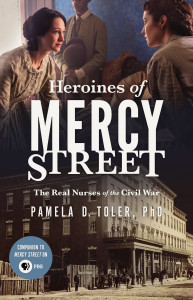By Pamela Toler (Regular Contributor)
 Tonight, like much of America, I plan to sit down and watch the first episode of PBS’s new historical drama about nurses in the Civil War, Mercy Street. (If you’ve watched anything on PBS or gone to the movies in the last few weeks you’ve probably seen the promotions for it.) Mercy Street uses a real Civil War hospital as the setting for a fictionalized (and quite gorgeous) drama. I’m looking forward to the show, but unlike everyone else in tonight’s audience I’ll be waiting breathlessly for the promotional spot at the end of the show, when PBS plugs DVDs of the show and my book, The Heroines of Mercy Street: The Real Nurses of the Civil War. My heart beats a little faster just thinking about it.
Tonight, like much of America, I plan to sit down and watch the first episode of PBS’s new historical drama about nurses in the Civil War, Mercy Street. (If you’ve watched anything on PBS or gone to the movies in the last few weeks you’ve probably seen the promotions for it.) Mercy Street uses a real Civil War hospital as the setting for a fictionalized (and quite gorgeous) drama. I’m looking forward to the show, but unlike everyone else in tonight’s audience I’ll be waiting breathlessly for the promotional spot at the end of the show, when PBS plugs DVDs of the show and my book, The Heroines of Mercy Street: The Real Nurses of the Civil War. My heart beats a little faster just thinking about it.
The Heroines of Mercy Street focuses on the same Civil War hospital as the series–Mansion House hospital in Alexandria Virginia–and some of the nurse who worked there.
When I began working on the book, I thought I knew something about Civil War nurses. Clara Barton first caught my imagination when I was seven or eight, thanks to a child’s biography that belonged to my mother. I had read Louisa May Alcott’s charming fictionalized account of her brief stint as a nurse in Washington D.C. . I had spent enough time at Civil War battlefields to learn more than I really wanted to know about amputations, conditions in field hospitals, and the symptoms and causes of dysentery.
I soon found that what I knew was only the beginning of the story.
By one estimate, more than 20,000 women served as nurses during the war, not including an unknown number of informal volunteers who put on aprons and rolled up their sleeves to help. They were as diverse as the new and expanding nation from which they were drawn: teenage girls, middle-aged widows, and grandmothers; society belles, farm wives, and factory girls; teachers, reformers, and nuns; free African-Americans and escaped slaves; new immigrants and Mayflower descendants. Some worked from patriotic zeal or a sense of adventure; others took the work because they needed the money. (In theory, the Union army paid $12 a month plus board, rations, and transportation; in practice nurses’ salaries were often months in arrears.) What they had in common was the physical capacity to do the work and a willingness to serve.
The women who worked at Mansion House can be seen as a microcosm for the medical experience of the war. Its nurses did battle with hostile surgeons, corrupt house stewards, dirt, filth, inadequate supplies, and their own lack of training. They fought to make sure their patients received the care they needed along with minimal comforts, wept for those they lost, raged at the enemy, and raged even harder against the indifference and inefficiency that left wounded men lying on the battlefield without care. They learned to dress wounds, bathe naked men with whom they had no familial relationship (not an easy adjustment to make at the height of Victorian prudery), and evacuate the building in case of fire. Worn out by the grinding nature of the work and exposed constantly to diseases, they themselves fell sick, often with no one to nurse them in their turn. Some lasted less than a month; others made the leap from volunteer to veteran. By war’s end their collective experience, along with that of nurses across the country, had convinced Americans that nursing was not only respectable but a profession.
To celebrate the publication of The Heroines of Mercy Street on February 16, I’ll share stories here about some of my favorite Civil War nurses over the next few weeks. You have a chance to share in the celebration, too.
Wonders and Marvels is pleased to have several copies of The Heroines of Mercy Street by our own Pamela Toler for giveaway. Sign up below before 11:00 PM EST on February 29 for a chance to win. Please note can only ship to US addresses at this time.
